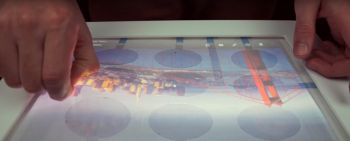Universities to develop shape-changing touchscreens
By: James Hakner
Last updated: Thursday, 25 August 2016

University of Sussex researchers have developed TableHop, a moving, fabric touchscreen that can be pinched and pulled.
An ambitious project to develop shape-changing, ‘living’ displays for phones and tablets will be launched at a Living Display Showcase at the University of Sussex on Tuesday 30 August 2016.
The event not only marks the introduction of the ‘Breaking Glass’ project, but will also feature live demonstrations to celebrate technologies developed as part of the GHOST (Generic and Highly Organic Shape-changing Technologies) project.
The Breaking Glass project will bring together world-leading researchers in human-computer interaction at Swansea University, the University of Sussex and the BBC to reinvent the “flat, dead surfaces” of current mobile technology.
The team behind the three-year, £800,000 Breaking Glass project, funded by the Engineering and Physical Sciences Research Council (EPSRC), promise to “challenge the perceived limitations of touch based displays.”
Project lead, Professor Matt Jones at Swansea University, explained: “Mobile phone and tablet touch screens are flat, dead surfaces. Our work seeks to explore the potential of a far more fluid, 'alive' portable display.”
Professor Sriram Subramanian of the University of Sussex added: “We will develop a range of fully-functional prototypes, scenarios in which they can be used, and an exploration of new interaction styles.
“We will create 3D mobile displays which you can literally grab, twist, pull and push. This will enable us to map out a design space to drive developments in both display materials and a richer, more expressive range of ways to interact with touch surfaces.”
The team – which has expertise in user experience, hardware and materials innovation, electronics, design-space analysis and biosciences – have devised a number of scenarios that illustrate the possibilities of the new technology. Professor Subramanian explained: “Imagine using a paint application on your tablet.
“At the top of the screen is a row of paint pots that dynamically recess into the display. Each contains a colour, and the deeper you dip your paintbrush into the pot, the deeper and thicker you are able to paint onto the remaining screen surface, just as in the real world of watercolour sets.”
The Breaking Glass project builds upon the extraordinary progress made by pioneers in the field of interactive design and technology.
The Living Display Showcase event will feature many of this progress as part of a celebration of the completion of the GHOST project, led by Professor Hornbaek from University of Copenhagen and involving Dr Alexander (Lancaster University), Professor Markopoulos (Technical University of Eindhoven) and Professor Subramanian (Sussex).
The project made international headlines last year when Professor Subramanian unveiled the world’s first sonic tractor beam.
The celebration will include live demonstration of technologies from the Universities of Sussex, Copenhagen, Swansea, Lancaster and Eindhoven.
Sussex’s demonstrations include:
- a moving fabric display that can be pinched and pulled
- floating graphs
- mid-air controls using haptics
- and live interactive art that you can experience on the day
Lancaster University will be bringing along Shapeclips, a technology that can turn any display into a shape-changing surface and use it to create 3D bar charts that rise out of the screen.
Finally, the Technical University of Eindhoven will demonstrate the growing DIY trend in the field, with their MorphBrix and SPOT projects.
